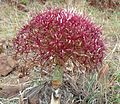Boophone
Boophone
Genus of plants
Boophone is a small genus of herbaceous, perennial and bulbous plants in the Amaryllis family (Amaryllidaceae, subfamily Amaryllidoideae.[2]) It consists of two confirmed species distributed across South Africa to Kenya and Uganda. It is closely related to Crossyne, a genus whose species have prostrate leaves.[3] They are drought tolerant but not cold-hardy, and are very poisonous to livestock.
| Boophone | |
|---|---|
| Inflorescence of Boophone disticha | |
| Scientific classification | |
| Kingdom: | Plantae |
| Clade: | Tracheophytes |
| Clade: | Angiosperms |
| Clade: | Monocots |
| Order: | Asparagales |
| Family: | Amaryllidaceae |
| Subfamily: | Amaryllidoideae |
| Tribe: | Amaryllideae |
| Subtribe: | Boophoninae |
| Genus: | Boophone Herb.[1][full citation needed] |
| Species | |
| Synonyms | |
| |
Boophone is the single genus in subtribe Boophoninae, in the Amaryllideae tribe.
Phylogeny
Boophoninae are placed within Amaryllideae as follows, based on their phylogenetic relationship:[citation needed]
| Tribe Amaryllideae |
| ||||||||||||||||||
Species
The list of Boophone species, with their complete scientific name, authority, and geographic distribution is given below.[4]
| Flowers | Plant | Scientific name | Distribution |
|---|---|---|---|
 |  | Boophone disticha (L.f.) [5][full citation needed] | From Sudan to South Africa |
 |  | Boophone haemanthoides Leight.[6] | From Namibia to the Western Cape Province |
Etymology
William Herbert wrote the name of this genus with three different orthographies: "Boophane" in 1821; "Buphane" and "Buphone" in 1825. This final spelling was corrected to "Boophone" in 1839 by Milne-Redhead. The name was derived from the Greek bous (an ox) and phone (death), due to its toxic nature to cattle. A proposal was published in 2001 to conserve the name "Boophone" and to take the earlier ones as synonyms.[7] This proposal was accepted in 2002.[8]
Larvae of the moth genera Brithys and Diaphone use Boophone as a food plant.
Boophone disticha is used in South African traditional medicine by the Zulu people to induce hallucinations for divinatory purposes, and also for various mental illnesses.[9] Its use, however, is limited by injuries that result from the plant's toxicity.[10] They have also been used as ingredients in traditional arrow poisons, and medicinal dressings for skin lesions.[11]
A variety of alkaloids with affinity for the serotonin transporter have been isolated from Boophone disticha.[12][13]
- Appendix: 18 (1821).
- Vigneron, P. (2000–2006). "Boophone". Amaryllidaceae organization. Archived from the original on 2009-07-16. Retrieved 2009-05-31.
- Royal Botanical Gardens, Kew. World Checklist of Monocotyledons: Boophone . Accessed May 16, 2009.
- Leighton, Frances Margaret. Journal of South African Botany 13: 59. 1947. [full citation needed]
- R. H. Archer; R. K. Brummitt; D. A. Snijman (2001). "Proposal to conserve the name Boophone Herbert with that spelling (Amaryllidaceae)". Taxon. 50 (2): 569–572. doi:10.2307/1223904. JSTOR 1223904.
- Richard K. Brummitt. 2002. Report of the Committee for Spermatophyta: 53. Taxon, Vol. 51, No. 4 (Nov., 2002), pp. 795–799.
- Stafford GI, Pedersen ME, van Staden J, Jäger AK (2008). "Review on plants with CNS-effects used in traditional South African medicine against mental diseases". Journal of Ethnopharmacology. 119 (3): 513–37. doi:10.1016/j.jep.2008.08.010. PMID 18775771.
- J. F. Sobiecki (2002). "A preliminary inventory of plants used for psychoactive purposes in southern African healing traditions". Transactions of the Royal Society of South Africa. 57 (1–2): 1–24. doi:10.1080/00359190209520523. S2CID 40983799.
- "Amaryllidaceae". succulent-plant.com. Retrieved 2018-02-07.
- Sandager M, Nielsen ND, Stafford GI, van Staden J, Jäger AK (2005). "Alkaloids from Boophane disticha with affinity to the serotonin transporter in rat brain". Journal of Ethnopharmacology. 98 (3): 367–70. doi:10.1016/j.jep.2005.01.037. PMID 15814274.
- Neergaard J, Andersen J, Pedersen ME, Stafford GI, van Staden J, Jäger AK (2009). "Alkaloids from Boophone disticha with affinity to the serotonin transporter". South African Journal of Botany. 72 (2): 371–4. doi:10.1016/j.sajb.2009.02.173.